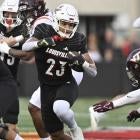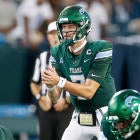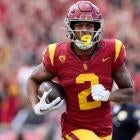Every offseason, without fail, one of the biggest buzz words in the NFL is "multiple." Every coach in the league talks about how they want to be multiple on defense. Three-man fronts. Four-man fronts. Nickel, dime, and base. In the offseason, everyone wants to do everything. But once the real games roll around, not quite as many teams are as multiple as they claimed they'd be. That's true largely because they don't have the personnel to operate that.
The Baltimore Ravens are at the opposite end of the spectrum. They're exactly as multiple as they claim they'd like to be every offseason because that's how they build their roster. Sure, they have players who do one specific thing will and are only asked to do that one specific thing, but they also prioritize finding versatile players who can fill different roles on any given snap. And this year is no different.
In Calais Campbell and Derek Wolfe, the Ravens brought in two players with extensive experience playing both on the interior and on the edge. And for Campbell, specifically, playing on both the right and left edges. Pass rushers like Jaylon Ferguson and Tyus Boswer have been used equally often from both sides of the line of scrimmage, which has allowed Matthew Judon (right) and Pernell McPhee (left) to lean more heavily to one side of the formation.
The chart below shows where several Ravens front seven players have lined up over the past three seasons (2017-19), broken down into plays on the interior, the right and left edges, and inside linebacker. All snap percentages come via Pro Football Focus game charting.
| DL/LB | % IDL | % EDGE RT | % EDGE LT | % ILB |
| Derek Wolfe | 62.9% | 35.7% | 1.1% | 0.3% |
| Calais Campbell | 18.0% | 38.0% | 43.2% | 0.8% |
| Brandon Williams | 96.3% | 1.7% | 1.6% | 0.4% |
| Jaylon Ferguson | 6.9% | 52.5% | 40.0% | 0.6% |
| Tyus Bowser | 0.0% | 44.2% | 48.0% | 7.8% |
| Matthew Judon | 0.7% | 36.1% | 55.3% | 8.0% |
| Pernell McPhee | 2.2% | 60.1% | 33.3% | 4.4% |
Campbell actually has even more versatility than it appears, because he was almost exclusively an interior defensive lineman during his days with the Cardinals before shifting primarily to the edge when he was with the Jaguars. McPhee has also been utilized far more creatively by Baltimore than he was with Chicago or Washington, where he spent the 2015 through 2018 seasons. The Ravens will line him up on either edge, but also over the nose or even as a stand-up linebacker on occasion.
The only guy here who really has just one job is nose tackle Brandon Williams, who is simply one of the best run-stuffers in the league. The wealth of depth they have outside of him allows the Ravens to limit Williams to doing what he does best, and still confront opposing offensive lines with one of the best fronts in the NFL.
The multiplicity also extends to the back end of Baltimore's defense. The Ravens have joined the ranks of teams who place a high priority on loading the field with defensive backs, and they have prioritized versatility within that unit. While Earl Thomas is primarily the free safety and Marcus Peters and Jimmy Smith are primarily outside corners, everyone has the ability to move around the formation. The chart below shows where Baltimore's defensive backs have lined up over the past three seasons, broken down by the percentage of time they aligned as a box safety, high safety, slot corner, outside corner, and linebacker or lineman.
| DB | % Box | % High | % Slot | % Outside | % DL/LB |
| Chuck Clark | 46.2% | 19.9% | 15.3% | 4.1% | 14.5% |
| Earl Thomas | 18.1% | 69.1% | 7.6% | 1.7% | 3.4% |
| Anthony Levine | 51.8% | 1.8% | 14.5% | 4.9% | 26.9% |
| Marlon Humphrey | 6.2% | 0.2% | 26.7% | 66.0% | 0.9% |
| Marcus Peters | 6.9% | 0.3% | 7.8% | 83.6% | 1.3% |
| Jimmy Smith | 4.7% | 0.4% | 4.6% | 89.3% | 1.0% |
| Brandon Carr | 11.9% | 3.9% | 20.2% | 61.7% | 2.2% |
As you can see, Thomas can move around quite a bit despite being primarily a center-field type, and the Ravens supplement him with two different kinds of box safeties in Chuck Clark and Anthony Levine. Peters and Smith are almost exclusively perimeter corners, but Humphrey went from playing 80 to 90 percent of his snaps on the outside in 2017 and 2018 to playing more than 70 percent in the slot last season. Having Carr as the No. 4 cornerback is a coup, because his versatility allows him to fill in for any of the three players ahead of him in the rotation on any given snap, and even to slide to safety in a pinch.
This group of 14 players represents about two-thirds of Baltimore's defensive depth chart, and they allow the Ravens to show a ton of different looks throughout any given game, depending on what the situation calls for. They've replenished their linebacker corps by selecting Patrick Queen and Malik Harrison in the draft, and they now have Justin Madubuike and Broderick Washington behind Campbell, Wolfe, and Williams up front. Add flexible Iowa safety Geno Stone to the safety group and it's easy to see how this team could remain versatile and multiple for years to come.






















